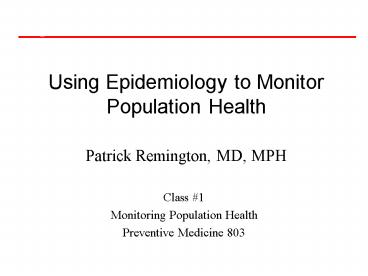Using Epidemiology to Monitor Population Health PowerPoint PPT Presentation
1 / 37
Title: Using Epidemiology to Monitor Population Health
1
Using Epidemiology to Monitor Population Health
Population Health Sciences
Patrick Remington, MD, MPH
Class 1 Monitoring Population Health Preventive
Medicine 803
2
Integrating Surveillance with Public Health
Programs
Program Implementation
Data Collection
Source Remington and Goodman Chronic Disease
Surveillance, 1999
3
Course Overview
- Reading
- Teutsch. Principles and Practice of Public Health
Surveillance - IOM. Improving health in the community
- Turnock. Public Health. What it is and How it
works. - Other book chapters and journal articles
4
Course Overview, cont.
- Homework assignments
- Due on Mondays
- Spend no more than 2-3 hours on each assignment
5
Course Overview, cont.
- Class Projects
- Population health data system description
- Descriptive analysis of a public health problem
6
Course Overview, cont.
- Population Health Data System
- Pick a population health data system
- Review the data system (examine data if available
online) - Find examples of analyses
- Prepare a report, describing the results of the
assessment
7
Course Overview, cont.
- Health Problem Analysis
- Pick a priority health problem
- Review the existing mortality data
- Develop a study protocol
- Write a final report for publication in the
Wisconsin Medical Journal
8
How do we measure the health of a population?
9
Definition of Epidemiology
- The study of the occurrence of illness
Rothman, 1986
10
Definition of Epidemiology
- The study of the distribution and determinants
of diseases in populations
CDC, 1988
11
Definition of Epidemiology
- The study of the distribution and determinants
of health and diseases, morbidity, injuries,
disability, and mortality in populations
Friis, 1996
12
Chain of Disease Causation
Health
Risk Factors
Conditions
Disease
Death
13
Definition of Epidemiology
- The study of the distribution and determinants
of health, risk factors, conditions, diseases,
and death in populations
Remington, 1998
14
Other Definitions
- Applied epidemiology The study of the
application of science into practice. Also
called consequential epidemiology.
15
Definition of Epidemiology
- The study of the distribution and determinants
of health, risk factors, conditions, diseases,
and death in populations
16
Determinants
- Analytic epidemiology
- Risk factors
- Important for disease prevention and control
17
Disease Spectrum
Health
Risk Factors
Conditions
Disease
Death
18
Disease Spectrum
Health
Physical inactivity
Diabetes
Heart attack
Death
19
Questions
- What are the risk factors for the disease?
- Is screening effective in reducing disease
mortality? - How can the burden from the disease be reduced?
20
Study Designs
- Observational Studies
- Descriptive
- Case-control
- Cohort
- Interventional/Experimental
- Clinical trials
- Community trials
21
Distribution
- Descriptive epidemiology
- Person, place, and time
- Measures of population health
22
Questions
- How much of the disease is occurring?
- How does the occurrence vary by person, place,
and time?
23
Study Designs
- Patient-based
- Anecdotes
- Case histories
- Population-based
- Time series
- Ecologic
- Cross-sectional
24
Summary
- Epidemiology the study of the distribution and
determinants of health, risk factors, conditions,
diseases, and death in populations - Monitoring population health assesses the
distribution in populations
25
Public Health Surveillance
- Ongoing systematic collection, analysis, and
interpretation of health data for use in
planning, implementation, and evaluation of
public health practice
26
Public Health Surveillance
- Closely integrated with the timely dissemination
of these data to the appropriate audiences.
27
Public Health Surveillance
- The final link in the surveillance chain is the
application of surveillance findings to disease
prevention and health promotion
28
What are the major sources of information of the
health of the population?
29
Types of Surveillance Systems
- Notifiable disease reporting system
- Vital statistics
- Sentinel surveillance
- Registries
- Health surveys
- Administrative data systems
30
Disease Spectrum
Health
Risk Factors
Conditions
Disease
Death
31
Disease Spectrum
Health (Quality of life surveys)
Risk Factors (BRFS)
Conditions (NHANES)
Disease (Hosp. d/c)
Death
32
Uses of Public Health Surveillance
- Estimate the magnitude of health problems
- Portray natural history of diseases
- Detect epidemics
- Document spread of disease
- Facilitate epidemiologic research
- Test hypotheses
33
Uses of Public Health Surveillance
- Evaluate prevention and control measures
- Monitor changes in infectious agents
- Monitor isolation activities
- Detect changes in health practice
- Plan prevention and control programs
34
Future of Public Health
- Public health successes
- CDC report, 1999
- Public health in disarray
- Need to strengthen core functions
- Assessment
- Policy development
- Assurance
35
Assessment
- Includes
- Surveillance, needs assessments, program
evaluation - Public sector role
- Private sector special interests
- Long range vision versus short-term gain
- This basic function of public health cannot be
delegated
36
Improving Health in a Community The Role for
Performance Monitoring
- A broader understanding of health
- Growing interest in performance monitoring
- Health care (HEDIS, NCQA, etc.)
- Public health (APEX, 2000 Objectives, etc)
- Framework for improving health
- Problem identification and prioritization
- Analysis and implementation cycle
37
Integrating Surveillance with Public Health
Programs
Program Implementation
Data Collection
Source Remington and Goodman Chronic Disease
Surveillance, 1999

